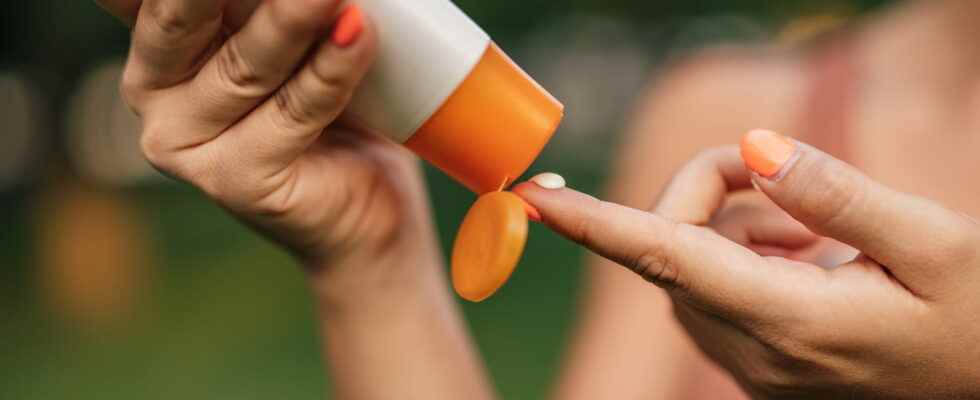Wearing sunscreen is an essential means of preventing skin cancer. But still it is necessary to avoid certain errors so that it really protects young and old!
Essential for preventing sunburn and the long-term risk of skin cancer, sunscreen is too often neglected. According to a Ipsos poll conducted for the National Syndicate of Dermatologists (SNDV), barely more than‘1 out of 2 French people puts it systematically or often on exposed parts which cannot be protected by clothing. A good application is essential to be well protected, especially in children. Reminder of mistakes to avoid.
Mistake 1: choose an index lower than 30
Matte, clear, tanned or not: in all cases, sunscreens with a protection factor of less than 30 do not provide enough protection from UV rays. “It’s pixie powder” had launched Claudine Blanchet-Bardon, vice-president of the SNDV, during a interview with France Info in 2017. Always choose a cream with an index of at least 30 if you have dark or already colored skin, and an index of 50 if you have fair skin and for children. Finally, keep in mind thatthere is no total screen!
Mistake 2: Reserve sunscreen at the beach
Sunscreens aren’t just for beach tanning. On the contrary, often the worst sunburns occur when you are not wary: walking in an alley to eat an ice cream or go shopping, during a lunch on the terrace… Remember that when you are going to expose yourself to sun, you have to get used toapply cream in the morning before leaving and renew the application if necessary. There are “mini” formats for sun creams, very practical in a bag!
Mistake 3: not checking the expiry date of the cream
Like most cosmetic products, sunscreen has an expiry date: no question therefore of using the tube of the previous year. In a pinch, you can recycle the tube of cream from your February ski holiday for August, provided it has been kept in a cool, dry place. On the other hand, if the cream has “turned” (it has changed in smell, color or texture), change it!
Mistake 4: exposing yourself without waiting
If possible, apply your sunscreen 15 to 30 minutes before going out: this ensures better skin penetration and halves the risk of sunburn.
Mistake 5: Applying too lightly
For optimal protection, apply your sunscreen every two hours. Don’t be sparing: apply generously to the areas most sensitive to the sun (face, décolleté…), without forgetting the nose, the ears, the shoulders, the back of the knees and the back of the feet.
Mistake 6: Avoid creams that leave marks
The nanoparticles are used in cosmetics because of their particularly interesting properties. In the sunscreen department, they make invisible the white marks left by the application, which in addition to being unsightly, are difficult to wash off. Problem: we know that these nanoparticles can penetrate the body, but we know neither their effects on humans nor on the environment. In the list of potentially dangerous components, we can cite the titanium dioxide and zinc. If in doubt, read the labels of your sun creams and prefer those that leave marks.
Mistake 7: Not applying cream because there are clouds
Just because there are clouds and the sun isn’t shining doesn’t mean the sunscreen should stay in the bag! As the site of the SNDV, “if the clouds and the wind slow down the infrared rays and with them the sensation of heat, UV rays, harmful to the skin, remain very present, despite the cloudy weather”.
Mistake 8: not reapplying cream after swimming
In water, exposure to the sun is even stronger due to the reverberation of the rays. You must use a water-resistant cream when you want to bathe and renew the application after each bath, regardless of the protection factor.
Mistake 9: prolong exposure with sunscreen
Contrary to what one might think, “sunscreen is not intended to increase your exposure time” recalls the SNDV. Sunscreen should be renewed every two hours regardless of its protection factor. And exposure should be avoided between 12 and 4 p.m.
Mistake 10: Take a special sunscreen for children
The laboratories offer products specially dedicated to children. In reality, these products are no different from those offered to adults: “The ingredients in these creams are the same as the others” confirms Claudine Blanchet-Bardon. As a reminder, babies should never be exposed to the sun. Children and teenagers must protect themselves in particular (index 50, no less!). Until puberty, skin and eyes are fragile and more sensitive to UV rays. Sunburn and repeated exposure during childhood are a major cause of the development of skin cancers in adulthood. Children should not be exposed between 12 p.m. and 4 p.m. Outside this niche, they must be protected with a T-shirt, briefs (or shorts) and sunscreen on the areas that protrude.
Source: National Syndicate of Dermatologists-Venereologists (SNDV).
